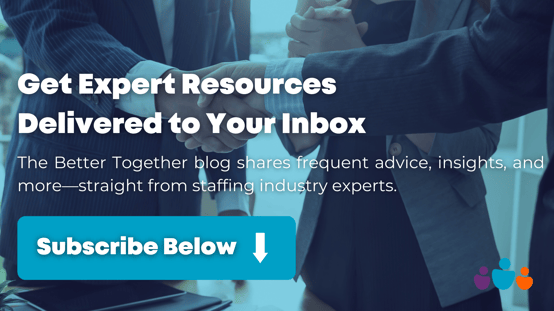How to Navigate the Impact of AI on Organizational Culture
The following is a guest post from Candace Coleman (CultureWise). Candace is a writer and editor with a background in publishing and public relations.
How to Navigate the Impact of AI on Organizational Culture

It wasn’t that long ago that AI sounded more like science fiction than a real possibility. Few comprehended that the technology would not only take hold but explode into widespread use, affecting almost everyone. And AI’s potential for being a game-changing advantage is why it has become firmly entrenched in the business world in little over a year.
But as the creators of AI have warned, this technology is a double-edged sword. Companies who use this powerful tool can unleash significant advantages and disadvantages.
Leaders who harness AI effectively can speed up processes, reduce errors, and grow profitability. It can also enhance their company culture if it is integrated with thoughtful planning. But those who don’t incorporate AI strategically risk undermining this rapidly evolving technology’s potential and incurring harmful repercussions instead.
What AI Can Do for Your Business
In most companies, tech-savvy employees were the first to research and test-drive AI before their leaders formally introduced it. They reported enthusiastically about its merits, leading many organizations to try it out in various areas. Mary Pratt lists significant ways AI can improve business operations in an article for TechTarget. The benefits of AI include:
- Making better decisions
AI accelerates and magnifies the ability to make data-driven decisions. The technology allows organizations to make more informed choices instead of relying on instincts and intuition that biases and preferences might influence. - Efficiency and productivity gains
Human effort can’t compete with AI in handling tasks requiring volume and speed. Pratt gives examples of searching for and analyzing data, creating software code, and executing specific processes. The technology frees up people’s time to perform higher-level work. - Improved speed of business
Pratt quotes author and CEO Seth Earley, who specializes in technology and maintains a positive outlook on AI in business. He explains that AI “speeds up the clock of the enterprise. It enables shorter cycles and cuts the time it takes to move from one stage to the next. That shortened timeline delivers better and more immediate ROI.”
- Improved services
“AI creates interactions with technology that are easier, more intuitive, and more accurate,” notes Thoughtworks Chief AI Officer Mike Mason, whom Pratt also cites in her article. He elaborates, “AI understands an unstructured query, and it understands unstructured data.” In marketing, for example, it can analyze a user's request and almost instantly present them with a finely tuned and highly accurate response.
- Better quality and reduction of human error
Companies can achieve higher compliance with standards by adding AI technologies to processes. For example, using AI in financial reconciliation vastly reduces the margin for error as opposed to when people handle the task.
- Improved talent management
AI can streamline and thus speed up the hiring process through highly efficient sourcing and screening. This can produce a more qualified applicant pool, leading to a high-performing team. It can also effectively gauge employee engagement, helping leaders recalibrate to better connect with their staff.
These improvements can increase production, growth, and the bottom line. They can also give staff members a better job experience by alleviating dull, repetitive work and helping them excel in their roles. When thoughtfully integrated into a company’s operations, AI can bolster employee engagement and strengthen workplace culture.
A Harvard Business Review article includes insight from Microsoft CEO Satya Nadella about AI’s benefits for workers:
“AI will remove the drudgery of work and unleash creativity. There's an enormous opportunity for AI-powered tools to help alleviate digital debt, build AI aptitude, and empower employees.”
How AI Could Harm Your Business
Despite AI’s many positive attributes, experts warn that the technology must be handled carefully. As the founder of one of the largest security awareness training platforms, Stu Sjouwerman is well-versed in the perils of misused AI. In an article for Fast Company, the KnowBe4 Inc. CEO cites the risks and dangers of this technology, including weakened accountability, transparency, fairness, privacy, and security.
Beyond these broader concerns, AI could disrupt an organization’s workforce if improperly introduced. The American Psychological Association details potential damage from AI in their 2023 Work in America Survey. Key APA findings include:
- Thirty-eight percent of workers worry that AI might make some or all of their job duties obsolete. Their concerns add to stress and other mental health issues that negatively affect people’s well-being and work outcomes.
- Forty-six percent of workers concerned about AI encroachment on their work responsibilities intend to look for new jobs, adding to the turnover trend plaguing many companies.
A Future of Work article notes that employees developed these worries largely because most say their companies don’t have a policy about using AI. The article includes advice from Qualtrics Chief Workplace Psychologist, Dr. Benjamin Granger:
“The excitement among executives about AI is not surprising given the promise of more efficiency, but the concerns of employees are also well founded. Organizational leaders would be wise to remember that at their roots, organizations are simply groups of people and the bigger promise of AI is to help people be happier, healthier and more productive at work—outcomes that benefit everyone.”
To maintain a positive and sustainable organizational culture, leaders must ensure a smooth transition into this technology.
How Companies Can Reap the Benefits of AI
Experts agree that communication is the key to introducing AI into the workplace. Leaders must carefully relay information about AI’s role in the organization and its benefits to alleviate employees’ fear of the unknown.
Centric Consulting CEO Larry English offers advice to leaders in a Forbes article. He points out that each organization is unique in how it interfaces with AI.
“Every company will have its own cultural nuances in implementing a controversial and somewhat unpredictable technology. Everything from the nature of work for an organization to employee demographics and the IT security infrastructure in place will play a role in how AI is perceived, deployed, and used at an organization.”
One of the first things he recommends leaders do is anticipate their staff’s reaction to change. He suggests leaders consider:
- How they envision AI’s usage in the company
- How employees received previous changes
- Their employees’ appetite for innovation
- The level of trust in the organization
English points to research that shows an investment in AI will fail in companies with a non-innovative culture and whose leadership isn’t transparent about the risks and opportunities of new ideas. For example, a Boston Consulting Group Study shows that 70 percent of digital transformations in business fall short of their objectives. A report on the study concludes:
“The people dimension (organization, operating model, processes, and culture) is usually the determining factor. Organizational inertia from deeply rooted behaviors is a big impediment.”
English stresses that education and understanding are essential for companies to succeed with AI.
“When you have effective change management — clear and timely communications, targeted learning opportunities, and meaningful ways to share feedback and concerns — the introduction of innovations such as AI can be less intimidating and disruptive to the operations of an organization.”
To prevent fears that AI will eliminate jobs, English advises leaders to help employees grasp that this technology is “augmentation, not substitution.” It will reduce the load of time-consuming, monotonous tasks and give employees the bandwidth to do more meaningful work.
Adapting to AI will require employees to learn new skills and, in some cases, may propel them into new jobs. Leaders can frame these changes as career growth opportunities and make training programs and learning channels for staff part of the strategic plan to incorporate AI into the organization.
Amy Webb is an NYU professor, author, and CEO of Future Today Institute. In a Harvard Business Review article, she reminds leaders that AI is constantly evolving and advises them to plan for the future methodically.
“This requires resisting the temptation to reduce your workforce and instead use strategic foresight to create a future where AI is leveraged by a highly skilled workforce, and where human-AI teams are more productive, creative, and efficient working together than apart.”
AI will have exponential influence as it grows and evolves. Leaders must develop a culture of continuous evaluation and improvement to keep employees engaged and for their companies to remain competitive.
Inova Staffing Insights
 Dan Barnett, President & CEO of Inova Staffing, says:
Dan Barnett, President & CEO of Inova Staffing, says:
The integration of AI into the business landscape has undoubtedly reshaped the dynamics of our industry. The potential benefits, such as increased efficiency, improved decision-making, and enhanced talent management, align seamlessly with our commitment to delivering top-notch staffing solutions. However, it's crucial to acknowledge the potential challenges highlighted in the article, especially the concerns surrounding job displacement and the need for transparent communication during the implementation of AI. This article reinforces our commitment to maintaining a dynamic and forward-thinking culture at Inova Staffing as we navigate the evolving landscape of the staffing industry.
Interested in More Employment Resources?
Whether looking for a job or seeking new candidates, the Better Together Blog is packed with advice and insights to help you succeed. Subscribe below to receive the latest content in your inbox—directly from staffing industry experts.

Enter your email address to receive updates when we publish new content.



